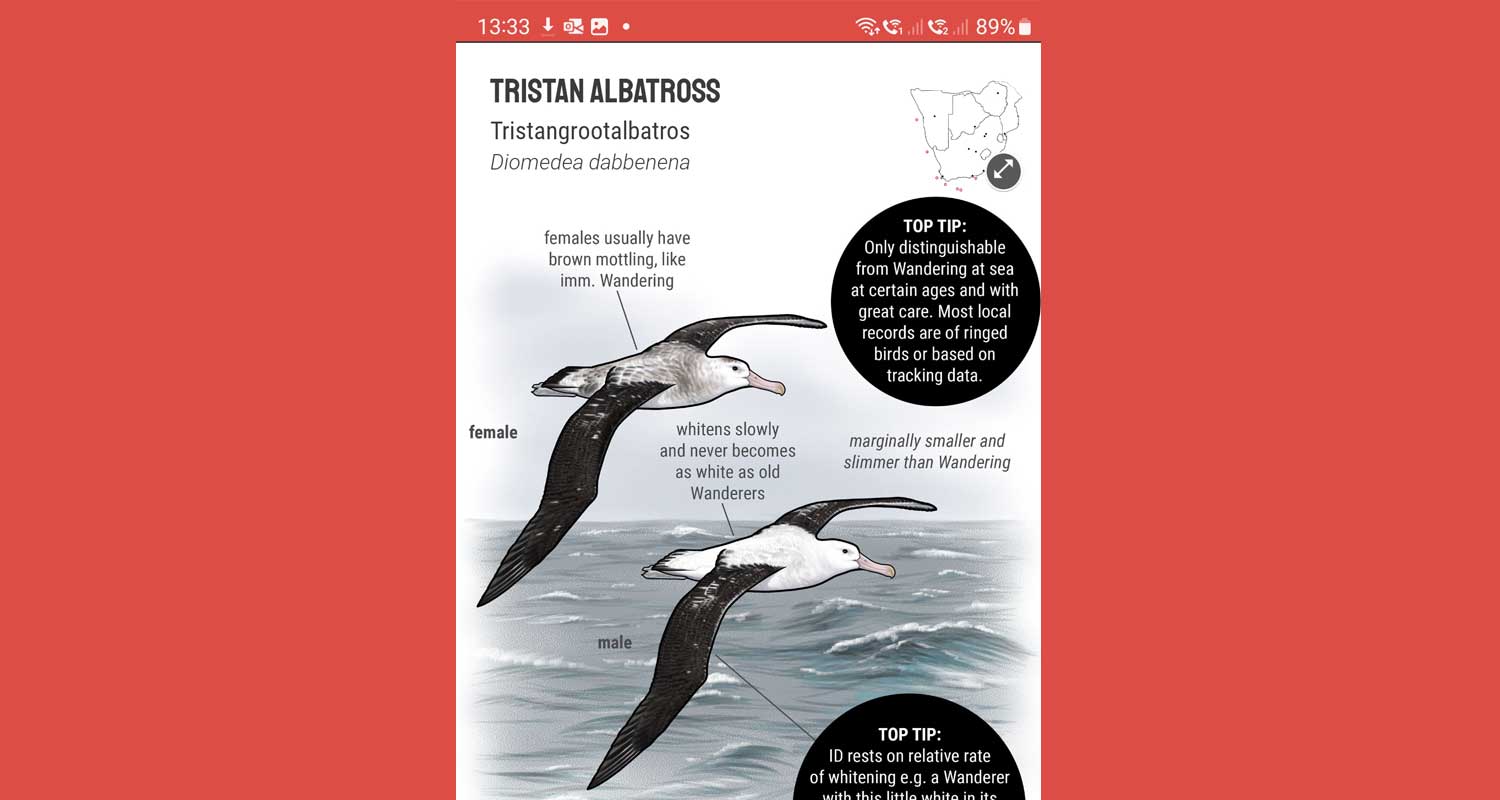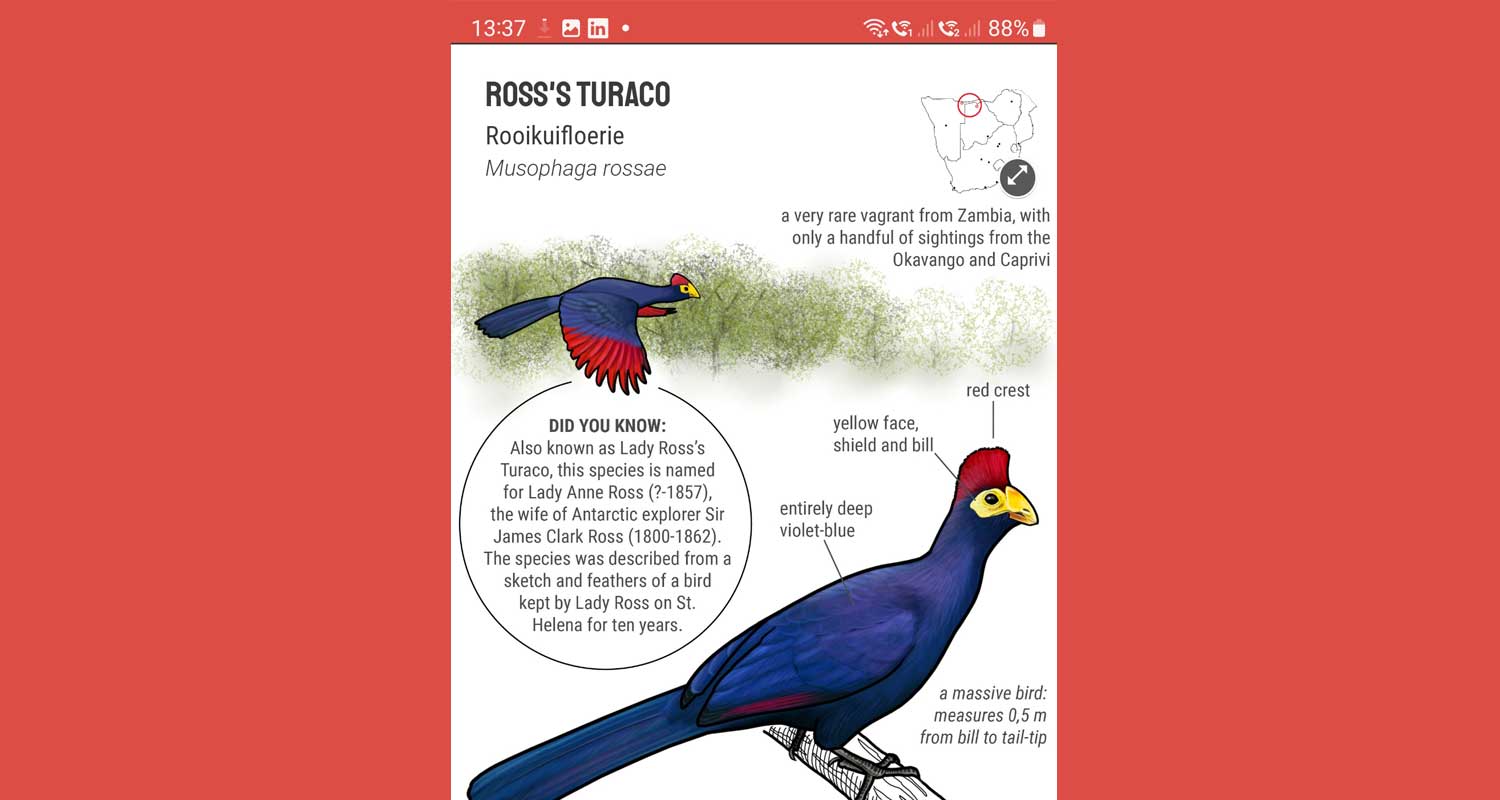 Firefinch is not a standard, quick-identification birding app. It includes illustrations, photos, sounds, maps, seasonal statistics and helpful tips for almost a thousand bird species, and expert birders will provide regular articles, birding hotspots and share the latest sightings and events.
Firefinch is not a standard, quick-identification birding app. It includes illustrations, photos, sounds, maps, seasonal statistics and helpful tips for almost a thousand bird species, and expert birders will provide regular articles, birding hotspots and share the latest sightings and events.
Faansie Peacock, who wrote the words and drew all the illustrations in the app, believes birding should be “a declaration of love for birds and an appreciation of the wild places and landscapes of Africa”.
“Birding has a strong scientific background, but you certainly don’t have to be an ornithologist to enjoy and understand birds. It doesn’t even matter if you know the name of the bird – as long as you enjoy watching it, whether it’s a majestic bearded vulture soaring over the Drakensberg escarpment or a gentle wagtail strolling around beneath the restaurant table,” Peacock said.
The team that developed the app tried to keep that in mind throughout, doing their best to avoid scientific jargon, “colour names” that no one really understands, or too much technical information.
In fact, you won’t find lengthy text write-ups in the app. All the key information is right there on the plate or photo. Everything is presented as visually as possible, with a liberal brush of artistic flair and anecdotes, too.
From the outset, the app developers agreed they didn’t want to have the app identify birds outright – because where’s the fun in that? Instead, users will learn how to identify birds confidently and have fun along the way.
Ebbie Swart, a user experience design lead at DVT, designed the interface of the app, with every icon, position and colour trialled through countless iterations before being sent on to his brother, Stephan, head of engineering at MagnaBC, to code.
Firefinch, which currently costs R600/year or R60/month for full access to the database, joins established South African birding apps like Sasol eBirds Southern Africa, Roberts Bird Guide and BirdPro, which BirdLife South Africa lists as the top three bird identification apps in the country.
Technical details
To streamline the process of content management, the developers opted to use a spreadsheet tool to organise the content into a database, using SQLite as the database management system, which is widely supported on mobile.
They have developed native Android and iOS apps using Kotlin and Swift, because the team had expertise in these technologies and they provide excellent performance and responsiveness for a field guide app.
The server infrastructure and backend rely on the Firebase app development platform. “One of the main reasons we chose Firebase as our server infrastructure is its robust support for offline/online capability. This means that even when users are offline they can still access and interact with the app’s content. Any changes made while offline are stored locally on the user’s device and automatically synchronised with the Firebase servers when an internet connection is available.
“Firebase offers a comprehensive suite of tools that handles user authentication, user management, notification management and server-side functions. It also provides Crashlytics, a tool that helps to identify and address any issues causing crashes in the app. Firebase manages user accounts, stores and syncs data, and uses serverless functions to enhance the app’s functionality,” said Ebbie Swart.
 Slack integrates with the backend services, including Firebase and RevenueCat, keeping the team informed about notifications, code commits, deployments and crash reports.
Slack integrates with the backend services, including Firebase and RevenueCat, keeping the team informed about notifications, code commits, deployments and crash reports.
For version control and collaborative development, GitHub allows the team to work together, track changes and manage the source code efficiently.
On the website side, they leverage Bubble.io, a no-code platform that simplifies website development.
“Using Bubble.io, we were able to build the website and create a blog site from scratch. Faansie, our ornithologist, uses this platform to create his captivating Dawn Chorus posts, which are then synchronised with Firebase, updating the app’s database,” Swart said.
Read: What it takes to build a successful mobile app in 2023
“A server-side function is triggered, and notifications are sent out to app users, informing them of the new posts. The app fetches the latest post from Firebase and displays it within the app. Bubble.io also allows us to manage website content and release notes, ensuring easy maintenance and updates.”
Miro and Figma were used as collaboration and design tools. These platforms allowed the team to collaborate, iterate on design concepts and create user-friendly interfaces. – © 2023 NewsCentral Media




